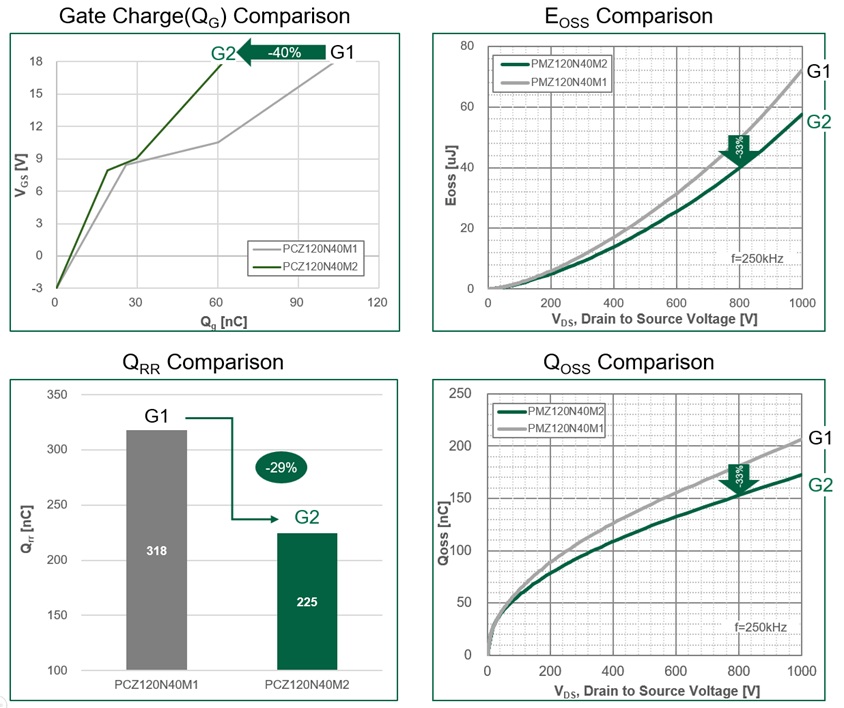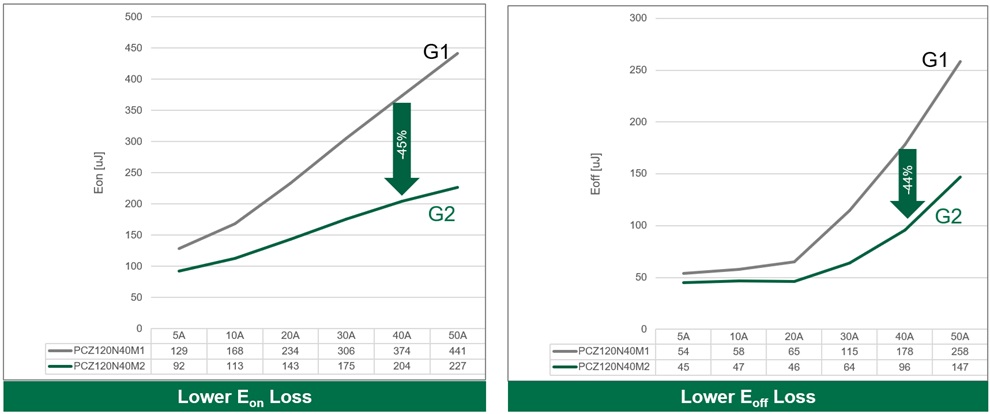-
LATEST NEWS / PRODUCT & TECHNOLOGY / SiC / WBG2 Min Read
Power Master Semiconductor (PMS) announced the release of its new AEC-Q101 qualified 1200V eSiC MOSFET in a D2PAK-7L package, designed to revolutionize power electronics in electric vehicles (EVs). PMS’s automotive-grade 1200V eSiC MOSFET offers superior efficiency, high power density, high reliability, and enables bi-directional operation, making it an ideal choice for a wide range of automotive applications, including on-board chargers (OBCs), DC-DC converters, and e-compressors.
The automotive industry is rapidly transitioning towards electrification, driven by the growing demand for sustainable and environmentally friendly transportation solutions. This shift has created a surge in demand for high-performance power electronics that can meet the stringent requirements of EV applications. Bi-directional operation is the key trend for the on-board chargers (OBCs) applications to meet V2L (Vehicle to Load), V2G (Vehicle to Grid), V2V (Vehicle to Vehicle), and V2H (Vehicle to Home appliance).
Therefore, the topology of OBCs is moving to Totem-pole PFC + CLLC or DAP resonant converter from Interleaved CCM PFC or Dual boost bridgeless PFC + LLC resonant converters. Larger battery capacity and faster charging demands are driving 800V battery systems for BEV application.
The automotive grade 1200V eSiC MOSFET is an optimized solution for the e-compressor, an indispensable power conversion system for efficient thermal management that increases battery life, charging efficiency, and driving range, and maintains a comfortable environment. It is also optimized for Totem-Pole PFC and CLLC/DAB (Dual Active Bridge) topologies, which are essential for bidirectional power conversion, a key trend in onboard chargers (OBC) for 800V battery system in electric vehicles.
Key Features of automotive grade 1200V e SiC MOSFET
- AEC-Q101 qualified for automotive applications
- Robust Avalanche Capability
- 100% Avalanche Tested
- Operating temperature range : -55°C to +175°C
- Low switching losses
- D2PAK-7L kelvin source package for ease of design and integration
“Driven by our unwavering commitment to innovation and sustainability, Power Master Semiconductor continuously develops power device solutions that achieve breakthrough efficiency and performance”, said Namjin Kim, Senior Director of Sales & Marketing.” The introduction of our new automotive-grade 1200V eSiC MOSFET represents a major leap forward in empowering the automotive industry’s shift towards cleaner, more energy-efficient power electronics. We are confident that this innovative solution will be the optimal choice for high-performance automotive applications.”
Original – Power Master Semiconductor
-
GaN / LATEST NEWS / SiC / WBG3 Min Read
Navitas Semiconductor released its 4.5 kW AI data center power supply reference design, with optimized GaNSafe™ and Gen-3 ‘Fast’ (G3F) SiC power components. The optimized design enables the world’s highest power density with 137 W/in3 and over 97% efficiency.
Next-generation AI GPUs like NVIDIA’s Blackwell B100 and B200 each demand over 1 kW of power for high-power computation, 3x higher than traditional CPUs. These new demands are driving power-per-rack specifications from 30-40 kW up to 100 kW.
Navitas announced its AI Power Roadmap in March 2024, showcasing next-generation data center power solutions for the growing demand in AI and high-performance computing (HPC) systems. The first design was a GaNFast-based 3.2 kW AC-DC converter in the Common Redundant Power Supply (CRPS) form factor, as defined by the hyperscale Open Compute Project. The 3.2 kW CRPS185 (for 185 mm length) enabled a 40% size reduction vs. the equivalent legacy silicon approach and easily exceeded the ‘Titanium Plus’ efficiency benchmark, critical for data center operating models and a requirement for European data center regulations.
Now, the latest 4.5 kW CRPS185 design demonstrates how new GaNSafe™ power ICs and GeneSiC Gen-3 ‘Fast’ (G3F) MOSFETs enables the world’s highest power density and efficiency solution. At the heart of the design is an interleaved CCM totem-pole PFC using SiC with full-bridge LLC topology with GaN, where the fundamental strengths of each semiconductor technology are exploited for the highest frequency, coolest operation, optimized reliability and robustness, and highest power density and efficiency. The 650 V G3F SiC MOSFETs feature ‘trench-assisted planar’ technology which delivers world-leading performance over temperature for the highest system efficiency and reliability in real-world applications.
For the LLC stage, 650 V GaNSafe power ICs are ideal and unique in the industry with integrated power, protection, control, and drive in an easy-to-use, robust, thermally-adept TOLL power package. Additionally, GaNSafe power ICs offer extremely low switching losses, with a transient-voltage capability up to 800 V, and other high-speed advantages such as low gate charge (Qg), output capacitance (COSS), and no reverse-recovery loss (Qrr). High-speed switching reduces the size, weight, and cost of passive components in a power supply, such as transformers, capacitors, and EMI filters. As power density increases, next-gen GaN and SiC enable sustainability benefits, specifically CO2 reductions due to system efficiency increases and ‘dematerialization’.
The 3.2 kW and 4.5 kW platforms have already generated significant market interest with over 30 data center customer projects in development expected to drive millions in GaN and SiC revenue, ramping from 2024 into 2025.
Navitas’ AI data center power supply reference designs dramatically accelerate customer developments, minimize time-to-market, and set new industry benchmarks in energy efficiency, power density and system cost, enabled by GaNFast power ICs and GeneSiC MOSFETs. These system platforms include complete design collateral with fully tested hardware, embedded software, schematics, bills-of-material, layout, simulation, and hardware test results.
“AI is dramatically accelerating power requirements of data centers, processors and anywhere AI is going in the decades to come creating a significant challenge for our industry. Our system design center has stepped up to this challenge delivering a 3x increase in power in less than 18 months”, said Gene Sheridan, CEO of Navitas Semiconductor. “Our latest GaNFast technology, combined with our G3F SiC technology are delivering the highest power density and efficiency the world has ever seen…the perfect solution for the Blackwell AI processors and beyond.”
Original – Navitas Semiconductor
-
GaN / LATEST NEWS / SiC / WBG2 Min Read
AIXTRON SE supports Nexperia B.V. in the ramp-up of its 200mm volume production for silicon carbide (SiC) and gallium nitride (GaN) power devices. With the new G10-SiC for the 200mm SiC volume ramp, Nexperia is placing a repeat order for AIXTRON SiC tools. This is complemented by an order for AIXTRON G10-GaN tools.
Both GaN and SiC epitaxial films are essential for the design of next-generation energy-efficient Field-Effect (FET) or Metal-Oxide-Field Effect (MOSFET) transistors to be used in various power conversion applications ranging from data centers and solar inverters in electric vehicles (EV) or trains.
Nexperia has decades of experience in the development of power devices, achieving more than 2.1 billion USD in revenue in 2023. After releasing its first GaN FET device in 2019 and its first SiC MOSFET in 2023, Nexperia continues to expand its portfolio with new high-reliability and power-efficient devices.
Nexperia, headquartered in Nijmegen (Netherlands), operates front-end factories in Hamburg (Germany) and Greater Manchester (England). The AIXTRON epitaxy systems will be installed at Nexperia’s wafer fab in Hamburg (Germany), further strengthening the semiconductor production capabilities in the region. Nexperia’s Hamburg site produces approximately 100 billion discrete semiconductors annually, accounting for about a quarter of the global production of this type of products.
“We are honored to strengthen our alliance with Nexperia, a pivotal player in the semiconductor landscape. Our G10 epitaxy solutions are at the heart of this collaboration, bolstering Nexperia’s growth strategies and enabling the high-volume production of wide bandgap semiconductors for commercial applications. Together, we are setting the pace for the industry’s transition to more energy-efficient SiC and GaN solutions”, said Dr. Felix Grawert, CEO and President of AIXTRON SE.
“As we advance our technological capabilities and market presence in high-power semiconductor production, our strategic partnership with AIXTRON is transformative. Integrating the G10 systems will significantly enhance our wide bandgap technology development and production capabilities. We build on AIXTRON’s proven uniformity and leverage the additional productivity gains of AIXTRON’s G10 tools to scale up our production efficiently and cost-effectively. With the new G10 tools in our Hamburg facility, we are poised for further advancements in our production capabilities,” said Achim Kempe, COO at Nexperia B.V.
Original – AIXTRON
-
As part of a so-called Joint Lab at Fraunhofer IISB, AIXTRON SE operates equipment, works on process development for SiC epitaxy and runs a demo center for its customers. Joint Labs like this are a great opportunity for companies to collaborate with Fraunhofer IISB in an industry-compatible laboratory environment.
For the epitaxy Joint Lab, the awarded IISB team ensures the continuous fault-free operation of already 5 state-of-the-art G10 SiC reactors, and enables the installation of new systems with minimal downtime. By setting up automated metrology and by optimizing wafer logistics, workflows and data management, the team has also established a modern wafer characterization facility at the IISB with a fast feedback loop for AIXTRON.
Fraunhofer IISB is thrilled for its colleagues Rainer Apelt, Nino Fröbisch and Katharina Roßhirt-Lilla from the SiC Epitaxy Group of the Materials Department together with Christian Heilmann, Rainer Schönweiß and Christopher Torscher from the Infrastructure Group within the Central Services Department. Such outstanding results are the base for the success of the Joint Labs model at Fraunhofer IISB.
Original – Fraunhofer IISB
-
GaN / LATEST NEWS / WBG3 Min Read
Efficient Power Conversion (EPC) announced that it has moved one step closer to achieving preeminence in the gallium nitride (GaN) power semiconductor industry, as its intellectual property rights to this revolutionary technology were upheld for the third time in three months. The next-generation wide bandgap semiconductors developed by EPC are essential to artificial intelligence (AI), satellites, fast chargers, lidar, humanoid robots and many other transformational technologies.
The U.S. International Trade Commission (ITC) found two of EPC’s key patents valid and one, the Company’s foundational patent, infringed by Innoscience (Zhuhai) Technology Co., Ltd. and its affiliate, Innoscience America, Inc. The ITC’s recommendation comes on the heels of two recent decisions from the China National Intellectual Property Administration (CNIPA), which similarly validated EPC’s counterpart patents in China. The ITC initial determination is a significant milestone in solidifying EPC’s leadership in wide bandgap semiconductors and could lead to a ban later this year on importation of Innoscience’s infringing products into the United States.
“The ITC’s finding that Innoscience uses our patented technology without authorization puts EPC in an enviable position, as U.S. and Chinese regulatory bodies have upheld the validity of our patents,” said Alex Lidow, CEO and Co-Founder of EPC.
“The Commission’s recommendations validate nearly two decades of hard work, resources and R&D that went into developing EPC’s uniquely valuable intellectual property portfolio,” Dr. Lidow added.
Over the last 15 years, EPC has capitalized on its first-mover advantage to develop a broad portfolio of over 200 GaN-related patents and over 150 products, which include its rapidly growing family of integrated circuits, automotive qualified and radiation hardened devices.
Compared with traditional silicon-based power devices, GaN represents a significant leap, with higher efficiency, faster switching speeds, smaller size and lower cost. GaN power devices are integral to self-driving vehicles, medical and communications devices, next-generation rapid chargers, drones, satellites, data centers, e-bikes, solar power systems and humanoid robots, among many other applications. Most notably, EPC’s cutting-edge semiconductors are central to powering the AI revolution by significantly freeing up space for extra computing power while simultaneously reducing energy consumption.
The ITC’s preliminary ruling found both U.S. patents that EPC asserted against Innoscience valid. It also found “infringement [by Innoscience] of U.S. Patent No. 8,350,294,” EPC’s foundational patent used broadly across multiple industries. The second EPC patent, U.S. Patent No. 8,404,508, was found valid, but not infringed by Innoscience. The Commission’s final determination is expected to be issued on November 5, 2024.
Original – Efficient Power Conversion

